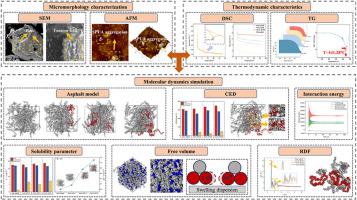Our official English website, www.x-mol.net, welcomes your
feedback! (Note: you will need to create a separate account there.)
Microscopic effect and mechanism of spray polyurea modifier on the asphalt binder: experimental characterization and molecular dynamics simulations
Polymer ( IF 4.1 ) Pub Date : 2024-11-16 , DOI: 10.1016/j.polymer.2024.127807 Xiaolong Sun, Hualong Xu, Xuehui Zheng, Xiao Qin, Tao Guo, Jianfeng Gao
Polymer ( IF 4.1 ) Pub Date : 2024-11-16 , DOI: 10.1016/j.polymer.2024.127807 Xiaolong Sun, Hualong Xu, Xuehui Zheng, Xiao Qin, Tao Guo, Jianfeng Gao

|
To investigate the impact of spray polyurea (SPUA) modifiers on the microstructure and performance of asphalt, SPUA powder prepared by cryogenic grinding was selected as modifier to explore the microscopic mechanisms of spray polyurea modified asphalt. Initially, the morphological characteristics of the SPUA modifiers were systematically characterized using morphological methods. Differential scanning calorimetry (DSC) and thermogravimetric analysis (TGA) were conducted to examine the effects of SPUA on the thermodynamic properties of asphalt. Finally, molecular dynamics simulations were utilized to model SPUA modified asphalt at different concentrations. Critical parameters such as cohesive energy density, solubility parameters, interaction energy, free volume, and radial distribution function (RDF) were analyzed to elucidate the microscopic mechanisms underlying the experimental results. The results indicate that the surface morphology of SPUA includes several pore structures, which enhance the tight and continuous bonding at the SPUA asphalt interface, thereby enhancing the microstructural stability of the modified asphalt. Additionally, incorporating SPUA increased the decomposition temperature of the asphalt binder, improving its thermal stability. This phenomenon is further validated by molecular dynamics simulations, which show that with increasing amounts of polyurethane, both the cohesive energy density and interaction energy of the asphalt system significantly increase, thereby enhancing the structural strength of the asphalt system. However, while low SPUA concentrations enhance the surface roughness of the asphalt, excessive SPUA may disrupt the uniform dispersion of the asphalt binder. This leads to a reduction in the difference in solubility parameters between the two components, diminishing compatibility, and decreasing the free volume fraction of the asphalt while increasing the peak of the radial distribution function curve. Such changes adversely affect the flowability and stability of the modified asphalt.
中文翻译:

喷涂聚脲改性剂对沥青粘结剂的微观效应及机理:实验表征和分子动力学模拟
为研究喷涂聚脲 (SPUA) 改性剂对沥青微观组织和性能的影响,以低温研磨制备的 SPUA 粉末为改性剂,探究喷涂聚脲改性沥青的微观机理。最初,使用形态学方法系统表征 SPUA 修饰剂的形态学特征。采用差示扫描量热法 (DSC) 和热重分析 (TGA) 研究 SPUA 对沥青热力学特性的影响。最后,利用分子动力学模拟对不同浓度的 SPUA 改性沥青进行建模。分析了内聚能密度、溶解度参数、相互作用能、自由体积和径向分布函数 (RDF) 等关键参数,以阐明实验结果背后的微观机制。结果表明,SPUA 的表面形貌包括多个孔隙结构,增强了 SPUA 沥青界面处的紧密和连续结合,从而增强了改性沥青的微观结构稳定性。此外,加入 SPUA 提高了沥青粘结剂的分解温度,从而提高了其热稳定性。分子动力学模拟进一步验证了这一现象,结果表明,随着聚氨酯用量的增加,沥青系统的内聚能密度和相互作用能都显著增加,从而提高了沥青系统的结构强度。然而,虽然低浓度的 SPUA 会提高沥青的表面粗糙度,但过量的 SPUA 可能会破坏沥青粘结剂的均匀分散。 这导致两种组分之间溶解度参数的差异减小,相容性降低,并降低沥青的自由体积分数,同时增加径向分布函数曲线的峰值。这些变化会对改性沥青的流动性和稳定性产生不利影响。
更新日期:2024-11-16
中文翻译:

喷涂聚脲改性剂对沥青粘结剂的微观效应及机理:实验表征和分子动力学模拟
为研究喷涂聚脲 (SPUA) 改性剂对沥青微观组织和性能的影响,以低温研磨制备的 SPUA 粉末为改性剂,探究喷涂聚脲改性沥青的微观机理。最初,使用形态学方法系统表征 SPUA 修饰剂的形态学特征。采用差示扫描量热法 (DSC) 和热重分析 (TGA) 研究 SPUA 对沥青热力学特性的影响。最后,利用分子动力学模拟对不同浓度的 SPUA 改性沥青进行建模。分析了内聚能密度、溶解度参数、相互作用能、自由体积和径向分布函数 (RDF) 等关键参数,以阐明实验结果背后的微观机制。结果表明,SPUA 的表面形貌包括多个孔隙结构,增强了 SPUA 沥青界面处的紧密和连续结合,从而增强了改性沥青的微观结构稳定性。此外,加入 SPUA 提高了沥青粘结剂的分解温度,从而提高了其热稳定性。分子动力学模拟进一步验证了这一现象,结果表明,随着聚氨酯用量的增加,沥青系统的内聚能密度和相互作用能都显著增加,从而提高了沥青系统的结构强度。然而,虽然低浓度的 SPUA 会提高沥青的表面粗糙度,但过量的 SPUA 可能会破坏沥青粘结剂的均匀分散。 这导致两种组分之间溶解度参数的差异减小,相容性降低,并降低沥青的自由体积分数,同时增加径向分布函数曲线的峰值。这些变化会对改性沥青的流动性和稳定性产生不利影响。


















































 京公网安备 11010802027423号
京公网安备 11010802027423号